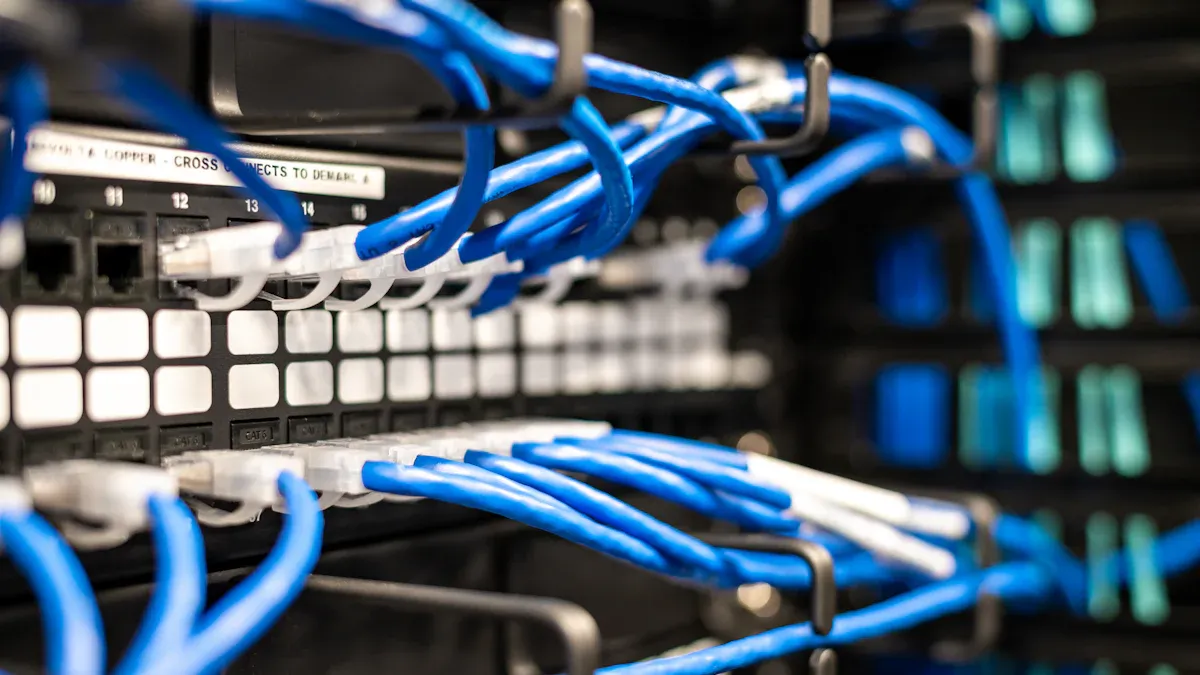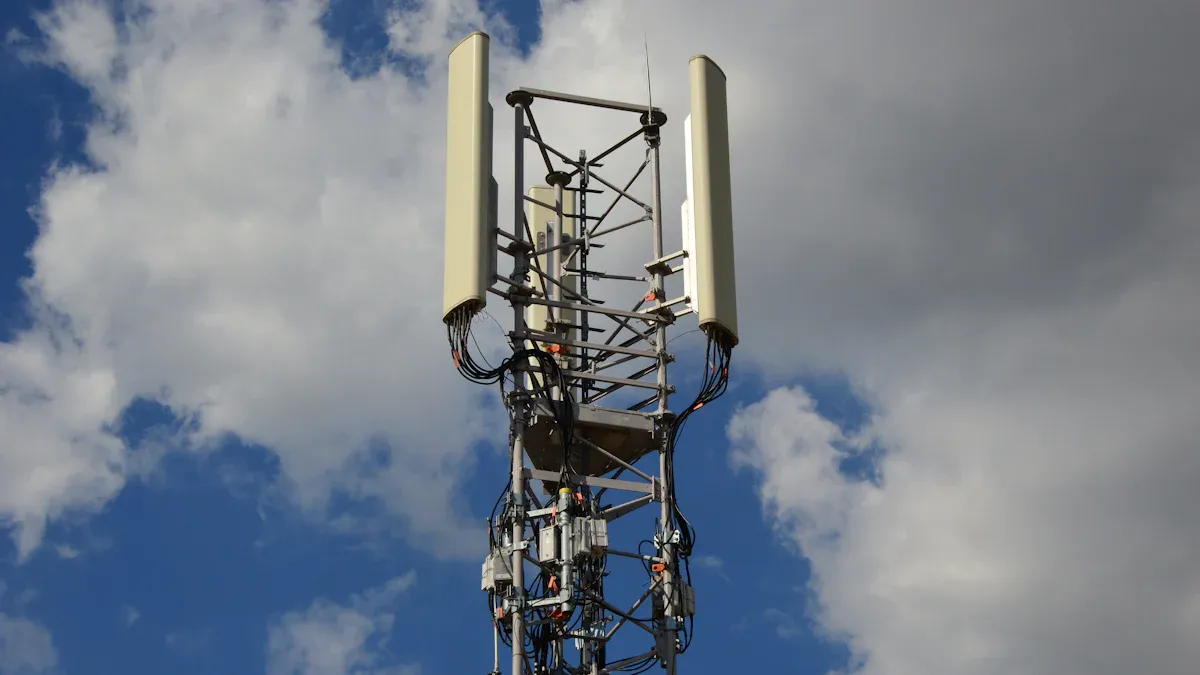5G Base Station Power Upgrade: Custom Rectifier Module Solutions for Outdoor/Indoor/Shared Cabinets

5G base stations have transformed network infrastructure by demanding significantly more power than their 4G predecessors. The table below highlights this dramatic increase:
Equipment Type | Load | AAU Power Consumption (W) | BBU Power Consumption (W) |
|---|---|---|---|
5G (ZTE) | 100% | ~1127 | ~293 |
5G (Huawei) | 100% | ~1175 | ~326 |
4G (ZTE) | 100% | ~290 | ~176 |
Operators now face several challenges:
Higher RF power amplifiers and complex physical-layer processing increase energy needs.
Band-specific amplifier design and regulatory compliance complicate deployments.
Power distribution networks experience added strain due to the higher electricity consumption.
A custom rectifier module offers a precise, scalable solution for these evolving power requirements in outdoor, indoor, and shared cabinet settings.
Key Takeaways
5G base stations need much more power than 4G, requiring upgraded power solutions to handle higher energy demands safely and efficiently.
Choosing the right cabinet type—outdoor, indoor, or shared—is crucial to protect equipment and ensure reliable power delivery in different environments.
Custom rectifier modules offer high efficiency, modular scalability, and advanced protection, making them ideal for modern 5G power needs.
Modular and hot-swappable rectifier designs allow easy upgrades and maintenance without disrupting network service, saving time and costs.
Proper installation with weatherproof cabinets, grounding, and regular maintenance extends equipment life and keeps 5G networks running smoothly.
Power Demands in 5G Base Stations

Outdoor, Indoor, and Shared Cabinets
5G base stations operate in diverse environments, each presenting unique power challenges. Outdoor cabinets must deliver reliable power despite exposure to harsh weather. Operators select cabinets with galvanized steel or aluminum construction and IP55 protection ratings to resist rain, snow, dust, and UV radiation. These cabinets often include power distribution units (PDUs) and backup power systems to maintain continuous operation. Advanced cooling systems, such as air conditioning and intelligent ventilation, help regulate temperature and prevent equipment failure.
Indoor cabinets serve base stations in controlled environments like data centers and office buildings. These cabinets use robust steel construction and focus on maintaining optimal temperature and humidity. Ventilation systems and lockable doors enhance security and equipment longevity. Power management in indoor cabinets prioritizes efficiency and reliability, supporting telecom equipment without the need for weatherproofing.
Shared or modular cabinets offer flexibility for operators managing multiple network technologies. These cabinets integrate PDUs, backup power, and environmental monitoring systems. Modular designs allow for customization and expansion, adapting to changing power requirements. Cooling and power management systems adjust to the specific needs of the equipment and environment.
Operators should evaluate cabinet type and environmental conditions before selecting power solutions. Matching the right cabinet to the deployment scenario ensures stable operation and protects sensitive equipment.
Cabinet Type | Typical Power Features | Environmental Conditions | Construction & Protection | Cooling & Power Management |
|---|---|---|---|---|
Outdoor | PDUs, backup power systems, telecom power handling for 5G | Rain, snow, heat, dust, moisture, wind, UV, temperature | Galvanized steel/aluminum, IP55 weatherproofing | Air conditioning, ventilation, air filters |
Indoor | Power management for controlled environments | Data centers, offices, controlled temperature/humidity | Robust steel, no weatherproofing | Ventilation, lockable doors |
Shared/Modular | PDUs, backup power, environment monitoring, scalable customization | Flexible, varies by deployment | Modular, customizable, expandable | Adaptable cooling and power management |
Legacy Power Limitations
Legacy power systems struggle to meet the demands of modern 5G base stations. Older rectifiers and distribution networks were designed for lower power consumption and simpler equipment. These systems often lack modularity, making upgrades difficult and costly. Operators encounter limited scalability, insufficient backup power, and outdated cooling mechanisms.
Legacy cabinets may not provide adequate protection against environmental hazards. Outdoor units with low IP ratings risk water ingress and corrosion. Indoor systems without proper ventilation can overheat, reducing equipment lifespan. Shared cabinets built for previous generations of technology cannot support the increased load or advanced monitoring required by 5G.
Operators must assess existing infrastructure and identify limitations before upgrading. Replacing legacy systems with custom rectifier modules enables higher efficiency, improved scalability, and better protection for critical network assets. This approach supports the transition to 5G and prepares the network for future expansion.
Rectifier Module Solutions

Efficiency and Advanced Topologies
Modern 5G networks require rectifier modules that deliver high efficiency and advanced power conversion. Operators should select modules with efficiency ratings above 95%, which significantly reduce energy loss and heat generation compared to older systems. The following table highlights the improvements in performance:
Performance Aspect | Modern Rectifier Modules | Previous Generations |
|---|---|---|
Efficiency | Above 91%, leading models >95-96% | Around or below 91% |
Power Capacity | Nearly double | Lower |
Protection Features | Advanced safeguards | Less advanced |
Scalability | Modular, hot-swappable | Less modular |
Example Systems | ESTEL 10U 36KW 48VDC, >96% efficiency | Older models, lower efficiency |
Advanced topologies play a crucial role in achieving these results. Bridgeless totem-pole power factor correction (PFC) circuits improve efficiency by shaping current waveforms and reducing harmonic distortion. LLC resonant converters provide soft-switching operation, which minimizes electromagnetic interference and further boosts efficiency. Synchronous rectification and wide-bandgap semiconductors, such as Silicon Carbide (SiC), enhance thermal performance and power density. These innovations allow the rectifier module to support 48VDC outputs at 2-3KW or higher, meeting the demands of massive MIMO and edge computing in 5G deployments.
Operators should prioritize rectifier modules with these advanced features to ensure reliable, energy-efficient power delivery for their 5G base stations.
Modularity and Scalability
A modular rectifier module design enables operators to scale power capacity as network requirements grow. This approach supports seamless upgrades and future-proofs the infrastructure. Key benefits of modularity include:
Easy capacity expansion by adding or removing modules as needed.
Plug-and-play architecture for quick integration and power adjustments without disrupting operations.
Hot-swap capability, allowing maintenance or upgrades without network downtime.
Standardized power shelves that simplify installation and upgrades across multiple sites.
Real-time monitoring and predictive maintenance through integration with AI and IoT technologies.
Improved fault isolation, minimizing the impact of failures to individual modules.
Operators can choose from a range of power output options, such as 2 kW, 3 kW, or 4 kW modules, with support for up to 12 kW total DC power in some systems. Hot-swappable modules ensure that maintenance does not interrupt service, while intelligent battery management and remote monitoring enhance operational flexibility.
Feature | Details |
|---|---|
Power Output Range | 2 kW, 3 kW, 4 kW per module |
Hot-Swappable | Yes, plug-and-play installation |
Integration | 19-inch rack mount, wall mount options |
Efficiency | Up to 97% |
Additional Features | Remote monitoring, battery management |
Tip: Modular rectifier modules reduce operational costs and support renewable energy integration, making them a sustainable choice for expanding 5G networks.
Installation and Protection
Proper installation and robust protection are essential for maintaining the reliability of rectifier modules in outdoor, indoor, and shared cabinet environments. Operators should select modules with at least an IP65 rating to ensure dust-tight and water jet-resistant protection. The table below summarizes common IP ratings:
IP Rating | Solid Protection Level | Liquid Protection Level |
|---|---|---|
IP65 | Dust-tight | Protection against water jets |
IP66 | Dust-tight | Protection against powerful water jets |
IP67 | Dust-tight | Temporary immersion in water |
Outdoor cabinets should use galvanized steel or stainless steel construction with weatherproof seals and UV-resistant coatings. Operators must seal cable entry points, ground the cabinet with resistance below 10 Ω, and place the cabinet in a clean, ventilated area. Regular maintenance, such as cleaning ventilation grilles, helps maintain protection and performance.
Advanced rectifier modules also include built-in safeguards against overloads, voltage fluctuations, and short circuits. Real-time monitoring systems track performance and detect faults early, enabling proactive management. Backup systems activate quickly during power failures, preventing service interruptions.
Note: When selecting a rectifier module, operators should verify compliance with industry standards (such as Telcordia GR-1089-CORE and EN 60950), ensure compatibility with existing infrastructure, and consider features like remote monitoring and intelligent battery management.
Key Features and Integration
Monitoring and Management
Modern rectifier modules for 5G base stations offer integrated power supply solutions that streamline AC distribution and enable advanced remote monitoring. Operators benefit from real-time tracking of performance metrics, including voltage, temperature, and power output. These features support proactive maintenance and reduce downtime.
Key monitoring and management capabilities include:
Real-time monitoring of battery health, system performance, and energy consumption.
Built-in safeguards such as overload protection, thermal management, and fault detection.
Remote management that allows operators to resolve issues before they impact service.
Integration with smart systems for predictive maintenance, which forecasts failures and reduces downtime.
Secure remote control using AES 256-bit encryption and authentication protocols.
Multi-protocol support, including Modbus, SNMP, and MQTT, which unifies data from legacy and modern devices.
Feature | Benefit |
|---|---|
Real-time Monitoring | Enables proactive fault detection and alerts for quick response. |
Predictive Maintenance | Reduces downtime by forecasting failures and scheduling repairs. |
Secure Remote Control | Protects system integrity and prevents unauthorized access. |
Rugged Hardware | Operates reliably in extreme temperatures and harsh environments. |
Reduced Site Visits | Lowers operational costs through remote updates and monitoring. |
Operators who leverage these integrated features can maintain high uptime and reliability, even in challenging deployment scenarios.
Rapid Deployment
Rectifier modules designed for 5G base stations support rapid deployment in both new and upgraded sites. Operators can expand power capacity by adding modules without replacing the entire power supply, which saves investment and shortens construction time. Compact and lightweight designs allow easy mounting in diverse locations, including outdoor, indoor, and shared cabinets.
Key factors that enable fast deployment:
Modular architecture allows quick expansion and integration.
Hot-swap functionality enables repairs or upgrades without shutting down the system.
Passive cooling and high reliability reduce installation and maintenance time.
Efficient power solutions minimize size and complexity, meeting increased power demands.
Battery backup and switching power supply capacity considerations streamline planning.
Operators can reuse original switching power supplies when capacity is sufficient, which accelerates project delivery. The use of GaN semiconductor technology supports passive cooling, eliminating bulky heat sinks and simplifying installation.
Hot-swappable modules protect 24/7 service continuity, which is essential for telecom infrastructure. This feature reduces mean time to repair and minimizes downtime risk during maintenance or upgrades.
Implementation Steps
Site Assessment
Operators begin by evaluating the existing infrastructure to determine its suitability for new rectifier module installations. They use the IEC 60721-3-5 standard to assess environmental conditions such as temperature, humidity, dust, and corrosive elements. This ensures reliability and safety for rectifier modules in different operational environments. Key steps include:
Conducting demand load analysis to understand connected and design loads.
Sizing feeders and transformers based on calculated requirements.
Performing load flow and voltage drop calculations to verify power flow and stability.
Checking compatibility for input/output voltage ranges, physical dimensions, and hot-swap capability.
Assessing environmental conditions and planning for future scalability.
Utilizing advanced monitoring features for real-time performance evaluation.
Tip: Operators should always plan for future expansion by evaluating long-term power needs and available physical space.
Module Selection
Selecting the right rectifier module depends on several criteria. Operators match modules to cabinet types by considering input supply, power capacity, efficiency, modularity, redundancy, space efficiency, and maintenance ease. The table below summarizes these criteria:
Criteria | Explanation |
|---|---|
Input Supply Type | Single-phase for low power; three-phase for high power typical in 5G. |
Power Capacity | Low (<10kW), medium (10-50kW), high (>50kW) to match cabinet needs. |
Efficiency | Above 95% to reduce energy loss and operational costs. |
Modularity | Enables scalability and customization for evolving needs. |
Redundancy | Fault-tolerant modules ensure uninterrupted operation. |
Space Efficiency | Compact designs fit various cabinet sizes. |
Maintenance Ease | Easy servicing supports operational continuity. |
ESTEL’s rectifier modules exemplify these features, offering high efficiency, modularity, fault tolerance, and advanced diagnostics. Their product range covers diverse power capacities, making them adaptable for outdoor, indoor, and shared cabinets.
Best Practices
Integrating rectifier modules into existing 5G base station power systems requires attention to technical and operational details. Operators use high-efficiency semiconductors like Gallium Nitride (GaN) for better frequency operation and compact design. They select high-performance transformers and inductors to minimize energy losses. Advanced thermal management systems operate at elevated temperatures, reducing failure risks. Bridgeless power factor correction techniques improve efficiency and reduce harmonic distortion. Operators also optimize circuit performance with advanced control algorithms and simulation tools.
Common pitfalls to avoid include neglecting surge protection, improper grounding, pest ingress, and lack of routine maintenance. Operators should seal cabinet penetrations, install surge suppressors, and conduct regular inspections. Safety protocols, such as using PPE and testing for live voltage, protect personnel during installation and troubleshooting.
Note: Integrated DC/DC converter modules simplify design and improve EMI performance, meeting the stringent requirements of modern 5G base stations.
Custom rectifier module solutions deliver high power density, energy efficiency, and modular scalability, enabling telecom operators to future-proof 5G networks for rising power demands. The table below highlights key features that support flexible growth and sustainable operations:
Feature/Metric | Description/Impact |
|---|---|
High Power Density | Delivers more power in the same form factor, reducing capital expenses. |
Modularity and Scalability | Allows flexible scaling and customization for evolving network needs. |
AI-driven Predictive Maintenance | Reduces downtime and maintenance costs. |
Renewable Energy Compatibility | Supports solar, wind, and battery systems for steady power supply. |
Operators should select power solutions tailored to cabinet environments and plan for modular scalability. Recommended steps include consulting with solution providers, choosing weatherproof cabinets, and integrating advanced thermal management and remote monitoring.
FAQ
What factors should operators consider when choosing a rectifier module for 5G cabinets?
Operators evaluate efficiency, scalability, protection rating, and compatibility with existing infrastructure. They select modules with high efficiency, modular design, and robust environmental protection. These features ensure reliable operation and easy future upgrades.
Tip: Always verify module compliance with industry standards before installation.
How do hot-swappable rectifier modules simplify maintenance?
Hot-swappable modules allow technicians to replace or upgrade units without shutting down the base station. This feature minimizes service interruptions and reduces repair time. Operators maintain network uptime during maintenance activities.
Hot-swap capability
No downtime required
Quick replacement process
Can operators integrate renewable energy sources with custom rectifier modules?
Yes, many rectifier modules support solar, wind, and battery systems. Operators connect renewable sources to compatible modules, enabling sustainable power supply and reducing operational costs.
Energy Source | Integration Support |
|---|---|
Solar | ✅ |
Wind | ✅ |
Battery | ✅ |
What are the best practices for installing rectifier modules in outdoor cabinets?
Technicians use weatherproof cabinets with IP65 or higher ratings. They seal cable entry points, ground the cabinet, and perform regular inspections. Proper installation protects equipment from moisture, dust, and temperature extremes.
Note: Routine maintenance extends equipment lifespan and ensures stable operation.
See Also
Essential Materials Needed For Outdoor Telecom Cabinet Construction
Ways To Maintain Consistent Power Supply In Telecom Cabinets
Key Outdoor Cabinet Specifications For Communication Devices
Latest Innovations Shaping Outdoor Telecom Cabinet Designs
Preparing Outdoor Cabinets To Support 5G And Future Networks
CALL US DIRECTLY
86-13752765943
3A-8, SHUIWAN 1979 SQUARE (PHASE II), NO.111, TAIZI ROAD,SHUIWAN COMMUNITY, ZHAOSHANG STREET, NANSHAN DISTRICT, SHENZHEN, GUANGDONG, CHINA

